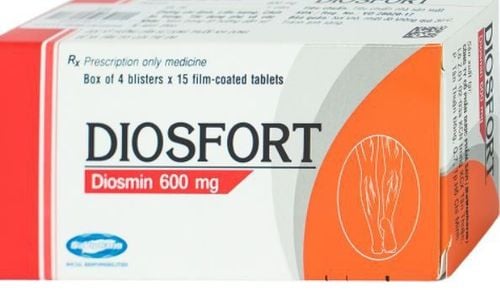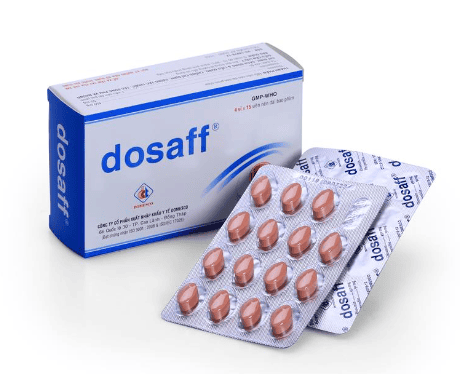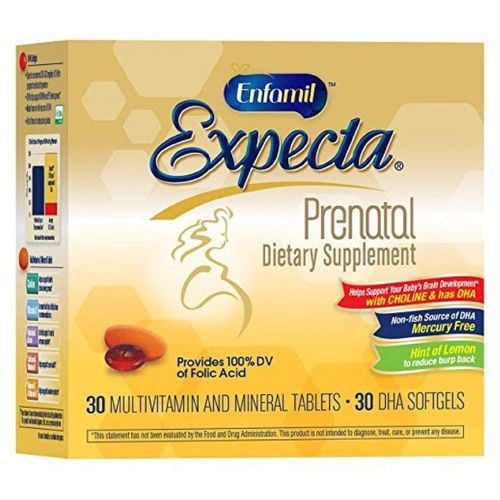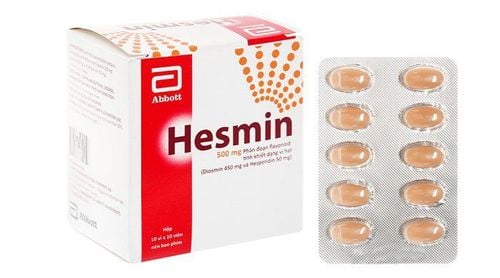This is an automatically translated article.
Venrutine is an over-the-counter drug that belongs to the group of vitamins and minerals. So, in what cases is venrutine prescribed to be used by many people?
1. What is Venrutine?
Venrutine drug is prepared in the form of film-coated tablets, the main active ingredients include Rutin 500mg and Vitamin C (Ascorbic acid) 100mg. Besides, it is also supplemented with excipients including: Povidon, Crospovidon, Manitol, Talc, Magnesium stearate, Ethanol 70%, Opadry red, Opadry transparent, purified water.
1.1. Pharmacodynamics Venrutine drug contains two main ingredients, Rutin and Vitamin C, they have the following properties:
Rutin, also known as Rutoside, is a flavonol glycoside composed of flavonol quercetin and disaccharide rutinose. Rutin is extracted from medicinal herbs: oranges, lemons, flower buds, buckwheat, chili peppers or from leaves of some species of Eucalyptus. Rutin has the effect of enhancing endurance and reducing capillary permeability, anti-edema, protecting blood vessels, and anti-inflammatory. The main mechanism of action of Rutin is to prevent oxidative damage to adrenalin in the circulation through competitive inhibition of the enzyme catecholamine-O-Methyltransferase. Rutin has anti-inflammatory effects through the mechanism of stimulating the adrenal gland to increase adrenaline secretion, inhibiting the enzyme hyaluronidase. Besides, Rutin has antioxidant, anti-tumor, antihypertensive, anti-thrombotic, cholesterol-lowering, and reduces the risk of cerebral hemorrhage and hemostasis. Vitamin C is necessary for collagen production, tissue regeneration in the body, participates in oxidation - reduction reactions, strengthens the immune system, enhances resistance to infections. Vitamin C is a powerful antioxidant that plays a special role in preserving the integrity of blood vessels, especially capillaries, and this effect is enhanced by Rutin. 1.2. Pharmacokinetics Vitamin C is readily absorbed from the gastrointestinal tract after oral administration. However, absorption may be limited with large doses. In some studies, only 50% of an oral dose of 1.5 g vitamin C was absorbed. Diarrhea or gastrointestinal diseases can reduce vitamin C absorption.
Normal plasma concentrations of vitamin C are about 10 - 20 mcg/ml, about 25% of vitamin C in plasma is combined with vitamin C. the protein. Vitamin C is distributed throughout the tissues of the body. Vitamin C oxidizes reversibly to dehydroascorbic acid. Some vitamin C is converted to inactive compounds including ascorbic acid-2-sulfate and oxalic acid which are excreted in the urine.
The amount of vitamin C in excess of the body's needs will be excreted in the urine as unmetabolized.
2. Indications and contraindications of the drug Venrutine
2.1. Indications Venrutine Hemorrhoids Subcutaneous hemorrhages, bruises Varicose veins Hypertension, capillary sclerosis Hemorrhage in odonto-stomatology, ophthalmology. 2.2. Contraindications to Venrutine Contraindications to the use of Venrutine include contraindications to its components Rutin and Vitamin C.
Contraindications to Rutin are hypersensitivity or allergy to rutin or one of its components. . Contraindications when using Vitamin C: Do not use high doses of Vitamin C for people with deficiency of G6PD enzyme (Glucose - 6 - Phosphate Dehydrogenase; patients with thalassemia; history of kidney stones, increased oxaluria or oxalate metabolism disorders.
3. How to take Venrutine
The specific dose of the drug for each patient depends on the health status and progression of the disease. It is best to consult your doctor for the right dosage. Venrutine is intended for use in adults and children 6 years of age and older.
For adults: take 1 tablet, use 1-2 times/day. For children from 6 years and older: take 1/2 tablet, use 1-2 times a day. Cases of overdose Rutin rarely occur. However, you may experience the following symptoms: dizziness, fatigue, fast heartbeat, muscle stiffness, upset stomach.
The overdose of vitamin C causes the patient to experience symptoms such as nausea, stomach pain, diarrhea. Treatment with infusions with diuretics may be helpful in this case.
Warnings and cautions:
High doses of Vitamin C (more than 3g/day) should not be used because of the increased risk of oxalate stones and urateuria. Use Venrutine with caution in patients with peptic ulcers. Pregnant and lactating women should use the drug under the guidance of a doctor.
4. Undesirable effects
Some possible side effects when taking Venrutine are: gastrointestinal disturbances, nausea, itching extremities, occasional headache.
Vitamin C can cause common side effects such as stomach cramps, nausea, heartburn, diarrhea, headache, insomnia, hemolytic anemia (in patients with G6PD deficiency). In addition, vitamin C excretes oxalate compounds and uric acid in the urine that can cause kidney stones. The risk of these side effects increases with higher doses.
You need to stop using the drug and consult your doctor when experiencing these unwanted side effects.
5. Interactions with other drugs
Do not use Venrutine with quinolone antibiotics because it may reduce the effect of quinolones because rutin competitively inhibits binding on the DNA-gyrase receptors that form Quercetin. Vitamin C contained in the drug Venrutine increases the absorption of iron from the gastrointestinal tract. Aspirin: Concomitant administration of vitamin C increases the excretion of vitamin C and decreases the excretion of Aspirin. Fluphenazine: Vitamin C reduces fluphenazine plasma concentrations. Limit the use of processed foods containing nitrates and nitrites while using the drug. Some studies suggest that rutin can be nitrified to produce mutagens. In summary, using Venrutine will help increase the therapeutic effect of this drug. Therefore, patients should always adhere to the prescription of medication from the doctor to avoid encountering unwanted risks.
Please dial HOTLINE for more information or register for an appointment HERE. Download MyVinmec app to make appointments faster and to manage your bookings easily.













